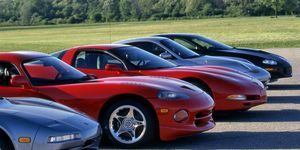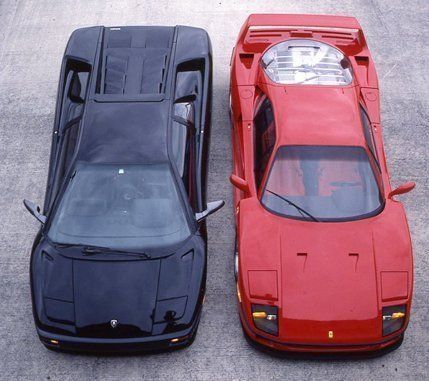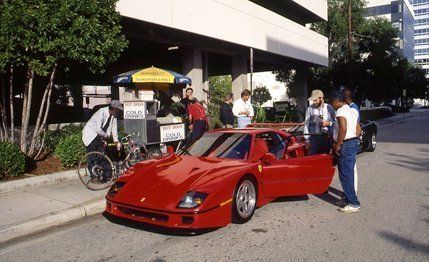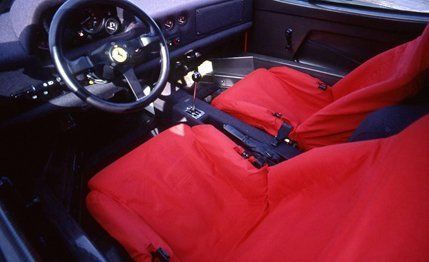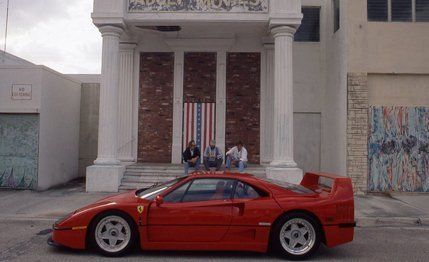From the April 1992 Issue of Car and Driver.
“It’s like a train speeding up your spinal cord and coming out your ear.” —Minnesota Vikings safety Joey Browner describing a full-force collision in the NFL
Which is pretty much how it feels to stomp the throttle of a Ferrari F40 or a Lamborghini Diablo on Interstate 95 at 11:30 in the morning. It gives you a brain full of buzzing horseflies.
From the logbook: “Just lit off both F40’s turbos, in second gear. Was actually bending steering wheel, trying to hold on, as if atop a tasered bull or a rocket-propelled grenade. Shift at 7000, head-snapping jolt, seismic shudder as wastegate thwacks after each upshift, big breath, eyes up, too easy to misjudge overtaking speeds.”
And we have them both, the Diablo and the F40. Same place, same time. The two current megastars of momentum, mass times speed as calculated in Maranello and Sant’Agata Bolognese. The two automobiles that most feel like a Scud balanced on the head of a pin. What we want to determine is what our readers keep asking in letters:
1. Which works better on the street?
2. Which is faster on the track?
Tim Murphy is the service manager of Shelton Sports Cars in Fort Lauderdale. He looks like a college professor and speaks like one, too, weighing each word carefully before issuing it. During the three days we drive the Ferrari F40 and the Lamborghini Diablo, he accompanies us as riding mechanic and two-legged encyclopedia of all matters Italian, failing to answer only one of our many questions: Where does Donna Rice live?
Murphy personally oversees the maintenance of both Italexotics pictured here. Both belong to the same man, a customer of Shelton’s who has logged fewer than 400 miles in either. That owner, who is at his West Coast home for the nonce and doesn’t care to tag along for our tests, purchased both automobiles during the initial feeding frenzies. He reportedly paid $775,000 for the F40 and $480,000 for the Diablo.
Murphy finds the cars and their $1.25 million cost neither intimidating nor particularly intriguing. He opens hoods and trapdoors and demonstrates switchgear deftly but matter-of-factly, like a salesman handling a $3000 Holland & Holland shotgun. “You will not find mechanical or engineering breakthroughs here,” he observes dryly. “Most people treat these cars as driveway jewelry. I don’t. You will learn that they are fast.”
We do.
What’s more, in their tractive ability to peel chunks of asphalt off the earth’s crust, the F40 and Diablo are surprisingly evenly matched. Both produce almost identical power and torque: 485 horsepower for the Diablo, 478 for the F40; 428 pound-feet of torque for the Diablo, 424 for the Ferrari. Both attain 60 mph in less than 4.5 seconds. Both catapult the quarter-mile in the twelves, at a velocity close to 120 mph. Both circulate the skidpad as if they were attached on stainless-steel tethers: 0.95 g for the Diablo, a neck-crimping 1.01 g for the F40. Both slurp fuel so voraciously that their combined guzzler tax is $10,100, and their combined luxury tax is $62,210—a sum sufficient to insert a new Cadillac Allanté in your garage. And both deliver top speeds that more than triple this country’s highest legal maximum.
Driving a Ferrari F40 and a Lamborghini Diablo nose to tail in downtown Fort Lauderdale renders us as conspicuous as Ted Kennedy at a car wreck. Curiously enough, it is also a passport to gentility. Motorists unanimously afford us unprecedented courtesy. Drivers let us merge. No one honks when we perform traffic-blocking three-point turns. No homeless persons at red lights attempt to wash our windscreens.
All of which is fortunate, because driving these cars in city traffic requires immense concentration. What should be excruciatingly enjoyable becomes a worry-fest: Is that Fairmont going to run the stop sign? Does the hardhat in the Bigfoot Bronco see my brake lights down here six inches above the pavement?
Maybe not. Open the F40’s doors and you have to watch whether they smack the curb. Not so the Diablo; its jackknife doors swing up and out of harm’s way, leaving a wide sill that doubles as an observation perch—which you need to sit atop, craning your neck over your shoulder when it comes to the frightening business of moving this car in reverse. What you see rearward out of both cars is more or less what you see through plywood peepholes around construction sites.
Stand on the Diablo’s throttle and you are rewarded with aural trauma. There is first a great whoosh of ingested atmosphere, followed by a booming, basso-profundo bellow that—inside, at least—sounds more like a big-block Chevy than an Italian V-12. The boom works out to 91 dBA, enough to annihilate the sweet Alpine stereo and CD player. The Ferrari’s interior seems tomblike by comparison—but, at 95 dBA, clearly isn’t. What’s missing is engine noise: the little V-8 ‘s howl is stifled by twin IHI turbos. What’s added is road noise: the F40’s hard-edged carbon-fiber cockpit is an excellent amplifier. Freeway expansion strips sound like .30-30 rifle shots.
We buy lunch from a man who introduces himself as “Don, of Don’s Carts Incorporated, owner and operator of mobile hot-dog vending units.” We park $1.25 million worth of cars in front of Don’s weiner trolley. He blurts: “Is this cash? If not, your credit may be good.”
As usual, crowds materialize from nowhere, clumping around both cars. As usual, onlookers are both fascinated and cowed. One teenager next to the Ferrari asks shyly, “May I touch it?” The gawkers often won’t speak until we tell them, “These cars don’t belong to us.” That somehow redefines us as envious gawkers too. Then, like clockwork, there follows a rush of questions. The first is always, “Which is faster?”
Among our group, nobody has praise for the Diablo’s double-decker instrument pod. On top are tach and speedometer; on bottom are water temp, fuel, and alternator gauges. It looks as if it were designed by a husband-wife team no longer speaking to one another. Although the Diablo’s steering wheel is adjustable for both rake and reach, no one finds a comfortable position that does not also obscure the pod’s queer penthouse.
Opening the rear deck of the F40 to expose the engine is a two-man job: One to hoist the 110-pound rear clip skyward, a clean-and-jerk operation that Nautilus should investigate. And another man to raise and insert—carefully, very care-fully—the prop rod. Performed sloppily, the whole works can come crashing down guillotine-style, scything arms, legs, and Cole-Haan loafers.
Around town, both of these cars are difficult to drive—heavy steering, high-effort brakes that are also vague, fussy metal shift gates. Without a fully warmed transmission, admission to first gear is often not an option.
Of the two, the Diablo is the more demanding, with more wasted motion. Its clutch is as heavy as that in a Ryder truck we recently rented. After one hour’s drive, no man among us could any longer hold the clutch depressed for the time required to outwait a red light. Under 10 mph, the steering is so heavy that you occasionally wrench your upper torso an inch or two from the nearly prone seatback. Lane changes require abiding faith in an omnipotent and benevolent being. What’s more, the Diablo’s gorgeous flying-buttress C-pillars—which are not so much C-pillars as extensions of the roof—reflect the sky so perfectly that nervous drivers mistake altocumulus formations for incoming Caprice-borne gawkers, who, as often as not, have already flanked the Lambo in outboard lanes anyhow.
Hot and thirsty, we head for a McDonald’s drive-thru. More tricky ground-clearance problems. Every pothole and ramp requires a trustee who walks ahead of both cars, making embarrassing hand gestures displaying clearance distances. We steer around a discarded McDonald’s bag, not worried that it will damage the car, just certain it will lodge in the F40’s grille. Both cars clean up on the highway, figuratively and literally. Attempting to lean low enough to hand a Coca-Cola to the Diablo’s driver, our McDonald’s server almost tumbles out of his drive-thru window. He sees the F40 next in line, whistles softly and says, “Holy jeez, Marie.”
In the F40, you sit encased in a carbon fiber seat—a shell padded with perhaps a quarter-inch of Nomex—and your legs are skewed five inches to the right, like in an IMSA GTP car. Compared with the Diablo, the seats are bolt upright; they breathe freely and are remarkably comfortable. The F40’s nonadjustable steering wheel is slightly canted from the driver at the top, requiring a Ralph Kramden stance. And the instruments, although nicely placed, have too many numerals crammed on their faces. You tend to watch only the vitals: tach and oil-pressure gauge, the latter in the middle of the dash, above the shift lever. It requires forethought.
Although the F40 is turbocharged, its engine is uncharacteristically responsive, even below 4000 rpm—the region in which the turbos have not yet spooled up full thermonuclear thrust. Unfortunately, from a standstill, the F40 jerks away, an inch of clutch travel equaling three feet of forward motion. Slipping the clutch helps until Murphy waves us off, his professorial nose having detected a familiar rum-soaked-cigar odor wafting into the cockpit. “Forget about being smooth,” he advises.
Despite the F40’s diminutive dimensions (and despite a tall carbon-fiber sill that is less easily climbed than rappelled), its interior feels downright airy and spacious compared with the Diablo’s. No leather padding impinges, no gaudy furbelows distract. The top of the Ferrari’s doors aren’t as high. And, unlike in the Lambo, there is no massive center tunnel dividing the front seats.
The lasting impression from our two days of city driving: The Ferrari is, on an admittedly bizarre relative scale, light, nimble, agile, and notably fond of fouling its plugs. The Lamborghini is bulky, deliberate, and evidently fond of cheesecake: the leaping bull is 500 pounds fatter than the prancing horse, and you feel the flab the moment you let out the clutch. Jumping from Diablo to F40 is like jumping from Mitsubishi 3000GT to Mitsubishi Eclipse.
From the logbook: “Thursday night, at a restaurant called Mario’s East. Where—as has become our custom—the cars are parked in view, or we are promised they will be guarded. A man who looks like a parking valet but turns out to be a head waiter motions us toward two slots near the main entrance—slots already occupied by a white 500SL and a black X16. ‘Wait just a second,’ he shouts, gesturing at the Benz and Jag as if they are derelict Kenmore refrigerators, ‘I’ll clear these out.’ He races inside and returns with keys, having interrupted who knows how many dinners.”
Ferrari and Lamborghini would have you believe that, although these cars are largely hand-built, they are nevertheless thoroughly modern. There is scant evidence to support this claim. After only three days—much of that time given to photography—both vehicles require the near-constant ministrations of riding mechanic Murphy.
The Diablo’s fix-it diary:
· Huge air leak in left corner of driver-side window.
· Driver’s lap belt won’t retract.
· Triangular piece of unidentified, gooey-surfaced plastic trim is rolling around footwell.
· Fuel-filler flap won’t lock.
· Greyhound-sized windshield wiper, despite carbon-fiber downforce tabs, begins to lift off beyond 80 mph.
· Ominous groan from rear bulkhead; a half-shaft or loose subframe assembly.
· Gear-shift knob ready to fall off.
· Door latches impossibly stiff, requiring two hands to operate.
· Fuel-filler cap jams.
· Right-side muffler begins to sag
· $600 lamb’s-wool floor mats foul clutch and accelerator pedals.
· Air-conditioning condensation tube strikes pavement.
· Accelerator linkage binds.
· Climate-control panel unfastens; appears it may fall out of dash.
· Hand-brake lever is wobbling.
· Driver-side door is unwilling to open entirely.
The Ferrari feels more solidly built and understandably so: It comes from Maranello attached to fewer pieces that can fall off. Some fall anyway. The driver’s door shifts on its hinges and begins to bind, grazing the blood-red paint. Until Murphy can adjust it, we are asked to scramble out of the car via the passenger’s door. Impersonating the Diablo, the F40’s driver-side lap belt refuses to retract. The rear brakes don’t just squeal, they scream. And the latches that hold the entire nosepiece begin to work loose, creating at 40 mph a unique whole-car harmonic that motivates Murphy to poke most of his slim torso out the passenger window so he can observe what is clattering. Fort Lauderdale passers-by are transfixed: here for their pre-Christmas entertainment is what appears to be a college professor who will momentarily fall out of a moving Ferrari.
Our third day strapped within the F40 and Diablo is spent entirely at Moroso Motorsports Park, where we run the cars both on the drag strip and around the 2.25-mile road course. We tap the talents of C/D helpmate Bill Adam, a former Group 44 driver and instructor in Derek Bell’s school. Adam has logged maybe 4000 laps at Moroso.
On the track, what we notice first is that the Lamborghini’s steering never lightens, even in 70- and 80-mph turns. The steering effort, in fact, seems to increase exponentially as you corner harder, punctuating its intransigence with an occasional wrist-wrenching jolt. Moreover, the Diablo’s shifter is ever balky, requiring so much concentration that it occasionally distracts from those pesky tasks of braking, turning, and adjusting the treble on our Aaron Neville CD.
On the back straight, we stage a rolling drag race, with the Lamborghini in second gear at 2000 rpm. Both drivers nail the throttles at the same moment. The Diablo squirts ahead two car-lengths, holding that lead for perhaps 100 feet. Then the Ferrari makes a major down payment on boost and rushes past like a red leopard after a skinny impala. After that, there is no catching it.
At the track, the Ferrari wins friends and influences corner workers. In contrast with the Diablo, its steering is two-fingers light. “You simply think it in the direction you want, like a race car,” observes Adam. The only heavyhandedness required —heavyfootedness, actually—is reserved for the brakes, which must be brutally stomped before they set about arresting the scary velocities the F40 seems to attain instantaneously between each of Moroso’s ten turns.
In any turn at any speed, the F40 is nearly neutral. We induce oversteer only with the grossest applications of full-boost thrust or with lift-throttle capers that few sentient beings would attempt on even the gentlest Interstate on-ramp. In fast transients, there is little sensation of weight transfer—Adam says it feels like the Ferrari is generating some ground effect. Dead-flat stability. Like a .22 Hammerlie with a laser sight, the F40 simply blasts ballistically wherever you aim it. At warp eleven.
Pushed hard, the Diablo, meanwhile, wants to understeer. We keep a close eye on its front tires, whose edges begin to feather and cup. What’s more, the Diablo’s tail wags in a subtle pendulum effect. The sensation is that the engine, hence the center of gravity, is twelve inches or so higher than the Ferrari’s.
We quickly develop driving styles tailored to each car. The Diablo prefers to enter turns cautiously, then draws on all its colossal torque for a moon-shot exit. The F40 goes in deeper and faster, requires merely a steady throttle (it is best to experience full boost when the F40 is aimed at a landing strip), then comes out as fat and fast as a salt-flat streamliner.
With the cars’ quirks laid bare, Adam cracks off three fast laps in each. He averages 1:29.4 in the Ferrari, 1:34.8 in the Lamborghini. A difference of more than five seconds per lap. And the F40, he reckons, “has another couple of seconds under its belt, if we fiddle with tire pressures and start using all of the track.”
Like a sore loser, the Lamborghini grumbles about this workout. Its brakes get hot and induce some pedal judder, its oil temp shoots to 130 degrees Celsius, its water to 110. Another cool-down lap, but the Diablo still sits and steams, as if darkly brooding.
So. What of our initial questions? Do these two benchmarks of Latinate art actually work as daily beaters on U.S. roads? We have the answer to this: No. Around town, both are as clunky and cantankerous as Strom Thurmond. Both are so mechanically delinquent that an onboard mechanic is advised. And both deliver a determined dose of driver discomfort found in few confined spaces this side of a Bangkok debtors’ prison.
So which, from point A to point B, is faster? We have the answer to this also. The Ferrari F40. Although it is every bit as impractical as the Diablo, it conducts its business like a lean, all-purpose predator. Darth Diablo works its magic from the other direction, doggedly attempting to dominate its driver, responding only to heavy hands and feet. And the moans and complaints from its coffin-size cockpit constantly remind that the true meaning of torque is twist.
Of course, if you are of a mind that these cars have less to do with mechanical brinkmanship than with social one-upmanship, then it is the Lamborghini that you require for sunset cruises on Biscayne Boulevard. Civilians vote with their eyes. By and large, they judge the Diablo’s figure more seductive than the F40’s. In our own south-Florida straw poll, women are virtually unanimous in this preference. If it matters to you, that is. (For us, the stylistic victor is secondary—one of those who-cares non-sequiturs, like the divorce lawyer who said, “She may have her faults, but Roxanne Pulitzer sure can balance a checkbook.”)
Our choice? We opt unanimously for the F40 and the train speeding up the spinal cord. Even though the Ferrari is $198,440 more expensive than the Lamborghini? Of course. Just tell your banker that the F40 is $928,625 cheaper than a General Motors SD-60 locomotive.
This content is created and maintained by a third party, and imported onto this page to help users provide their email addresses. You may be able to find more information about this and similar content at piano.io


